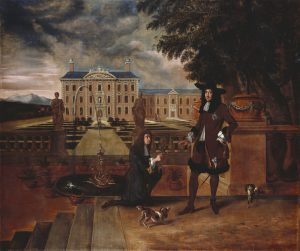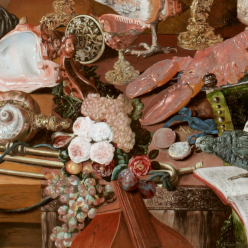
Charles II Presented with a Pineapple
Unknown painter, Britain, c. 1675-80
Oil on canvas.
96.6 x 114.5 cm
Royal Collection Trust
PROVENANCE: Presented to Queen Mary by Lady Mountstephen in 1926; formerly in the Bredalbane collection.
This oil painting’s subject is Charles II, King of Great Britain (1630-85). A kneeling man, possibly the royal gardener John Rose, presents Charles II with a pineapple in front of a large garden and house. The king is depicted wearing the typical fashionable clothing of the 1670s, which is unusual because he is normally painted wearing ceremonial robes or armour. Although in casual dress Charles II is presented with a symbol of royalty, the pineapple.
Out of the many fruits encountered in the ‘New World’, the pineapple was of special interest to European travelers due to its unusual form, taste, and qualities. Upon his first encounter with the fruit Spanish explorer Gonzalo Fernández de Oviedo declared it to be the unrivaled prince of all fruits. Even King Ferdinand gave the pineapple his highest praise. The pineapple became associated with royalty in Europe. The leaves on the top of the fruit are called the crown, so the pineapple certainly functions well as a symbol for kings. These royal connotations are incredibly illustrated by the Dunmore Pineapple, the ancestral home of the Earls of Dunmore built in 1761 with a fourteen meter tall pineapple crowning the building. The structure was designed to represent wealth and power and the royal symbolism of the pineapple was used to achieve this.
The pineapple presented to Charles II was claimed to have been the first pineapple grown in England. Although pineapples were later grown in Europe using hothouses, the date of the painting c. 1675-80 makes it is more likely that the pineapple pictured would have been imported. A certain parallel emerges between the pineapple and King Charles II beyond the royal status both enjoyed. In the painting a king who was both home grown and imported is presented with a royal symbol which is likewise home grown and imported.
Charles II’s father Charles I was beheaded in 1649 at the climax of the English civil war. The war, which lasted from 1642-1651, included wars in England, Scotland, and Ireland and become so intertwined largely due to Charles I himself. The Rump House of Commons created The High Court of Justice to try Charles I for treason against England for using his power to pursue personal interest rather than the country’s welfare. The court placed command responsibility on the shoulders of Charles I, holding him responsible for all the terrible things which had occurred during the wars. Despite Charles I’s refusal to recognize the court’s authority he was declared guilty and beheaded.
Although Charles II was declared king shortly after his father’s execution, he was unable to assume rule because England entered into the period known as the English Commonwealth. The country became a de facto republic headed by Oliver Cromwell. Charles II fled to mainland Europe after being defeated by Cromwell in battle. The dethroned king spent nine years in exile in France, the Dutch Republic, and the Spanish Netherlands. A political crisis following the death of Cromwell in 1658 resulted in the restoration of the monarchy. In 1660 Charles II was received in London as king.
Similar to the pineapple he was presented with in the painting, Charles II also had the dual identity of being homegrown and imported. He was homegrown because he was born and grew up in England while his father ruled and he was imported because he was returning to rule England after being in exile for nine years, a significant portion of his life. This is a moment where pineapples not only symbolize kingly qualities, but symbolize kings themselves.
Sources:
Charles II Presented with a Pineapple. c. 1675-80. Royal Collection Trust, Britain. Accessed October 12, 2018, https://www.rct.uk/collection/406896/charles-ii-presented-with-a-pineapple.
Kishlansky, Mark A, and John Morrill. “Charles I.” Oxford Dictionary of National Biography, September 23, 2004. Accessed October 12, 2018, http://www.oxforddnb.com/view/10.1093/ref:odnb/9780198614128.001.0001/odnb-9780198614128-e-5143.
Okihiro, Gary Y. Pineapple Culture: A History of the Tropical and Temperate Zones. Berkeley: University of California Press, 2009.
Oviedo, Gonzalo Fernandez de. Historia General y Natural de Las Indias. 1535. Book 7, Chapter 14.
Seaward, Paul. “Charles II.” Oxford Dictionary of National Biography, September 23, 2004. Accessed October 12, 2018. http://www.oxforddnb.com/view/10.1093/ref:odnb/9780198614128.001.0001/odnb-9780198614128-e-5144.
“The Pineapple.” National Trust for Scotland. Accessed October 12, 2018. https://www.nts.org.uk/visit/places/the-pineapple.
